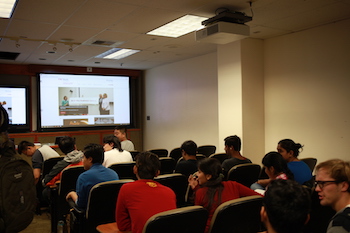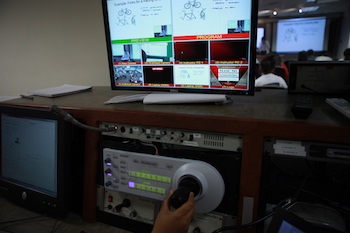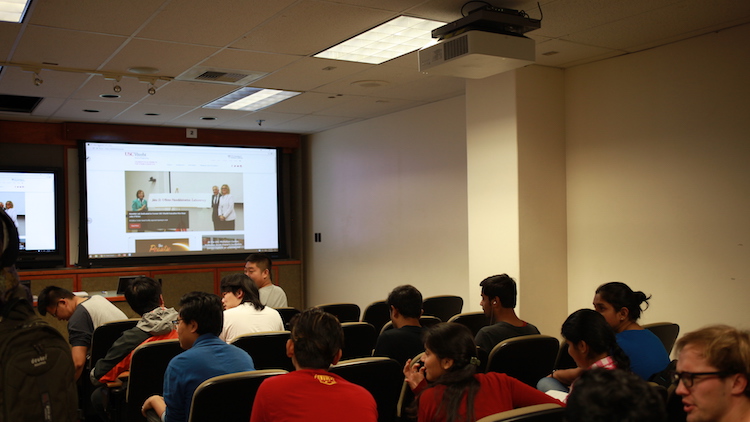
Sony’s laser projectors, including VPL-FHZ60, VPL-FHZ65, and VPL-FHZ700L provide improved images with less downtime. The Distance Education Network (DEN@Viterbi) in the office of Graduate and Professional Programs at the University of Southern California’s Viterbi School of Engineering relies on technology to help keep its on-campus and off-campus students engaged and informed throughout the course of their curriculum and to conduct two-way lectures and discussions in real time. Positioned at the top of U.S. News and World Report’s rankings for online graduate information technology programs and graduate engineering programs, the school offers 37 different Master’s degrees, five graduate certificate programs, and multiple executive education offerings, which can be obtained without physically setting foot on the campus. Teaching rigorous coursework to remote and in-person students simultaneously creates a need for the latest advancements in educational technology to ensure a collaborative and connected learning environment for global participants. The DEN@Viterbi team found that Sony’s remote-controlled cameras and laser projectors provided the experience and quality they needed, while being easy enough for student workers to learn and operate.
While the DEN@Viterbi classrooms look like regular classrooms, their lectures are broadcast live using Sony’s BRC-H700, BRC-H800, and BRC-H900 cameras and remote controllers. Traditional on-campus students benefit from the presence of Sony’s laser projectors, including VPL-FHZ60, VPL-FHZ65, and VPL-FHZ700L and the distance students benefit from the high-quality video recordings generated from the Sony equipment.
Dominic Lau, director, IT and operations detailed how the school’s reputation as the number-one online program required tools that matched its cutting-edge status and complemented each instructor’s unique pedagogical style, from PowerPoint to SMART Board, to video, and even pen and paper. “We push ourselves to set the pace for all distance education programs by providing the latest and greatest technology,” he said. “So when we see that there's deficiencies in some of our existing equipment or workflow, we definitely need to improve upon it. In the end, we make technological decisions based on what is the best quality, by conducting side-by-side comparisons. We brought in other cameras and projectors from other brands and we found that the Sony products outperformed the competitors.”
Lorenzo Casas, assistant manager, instructional operations engineering said that the relationship with Sony was built out of the school’s need for a “better performing projector.” His team wanted to explore different options and manufacturers and after spending time with the Sony models, liked what they saw. Speaking on his first impressions of the Sony projectors, Mike Sheldon, instructional operations engineer commented, “Both picture quality and the closeness of the color rendition were key factors in our decision. An important element we experienced during the installation phase is the projector’s image keystoning flexibility and precision, as well as the image warping. These features allow us to square in the image, and I haven't seen anything like it before. It stands out on its own.”

The PTZ cameras’ intuitive joystick control allows the faculty to quickly train new student operators each semester. Of their previous projectors, Nadia Barosy, manager, instructional operations said, “One of our professors actually commented on the output of the old projectors that we had, saying that it was too dim for him to see and the picture quality wasn't up to par. We recently replaced it with one of the Sony projectors and the professor could immediately tell the difference, because the image is so much brighter and sharper than it was previously.”
Lau favored Sony’s lampless laser projectors, after years of using projectors with bulbs. “I like the fact that we have gone away from replacing projector bulbs, which means less money for us to spend, while also saving time,” he said. “Some of the projectors are mounted high up in the ceilings and changing bulbs is a time-consuming process.”
Sheldon echoed Lau’s comments. “It has been a time-saving solution for us. The fact that we don't have to find time to replace projector lamps has been a huge benefit. Before, we would have to pull out a 20-foot ladder and climb up to replace those lamps. We could do it within an hour, but we'd have to change the lamps in most classrooms, nearly every semester.”
Barosy also commented on the time the projectors saved. “In terms of preparation, the fact that our projectors come on quickly make it very efficient, allowing us to maximize our instructional time,” she said. “We often have a 10-minute gap between classes, which allows minimal time for one professor to end and a new professor to come in. Even if a professor goes into a classroom that wasn’t just in use, you can turn the projector on in less than 30 seconds, which is greatly beneficial. In the past, it would take minutes to come on—from power up, to warming up, and then the image finally displaying on the screen. These minutes saved are priorities when it comes to professors being able to use their time efficiently and effectively in class.”
Additionally, she provided insight into how the school’s three PTZ cameras—at the rear of the classroom to show the professor or their presentation, overhead to show notes and props, and an audience camera which captures the students and their interactions—are all managed through the use of one controller and are primarily managed by the students. “We hire student workers to operate the equipment in a separate control room,” Barosy said. “A majority of the time, they're not very well versed in camera technology, so we definitely need equipment that make the technical aspects of camera operating as simple as possible for the novice. Having the joystick with built in PTZ capabilities for the camera provides integrated control, which is very helpful to us.”
She went on to explain how this ease of use translates to greatly reduced training time, which is crucial for the 60-plus student workers juggling the demands of classes, work, and their personal lives, who are operating and controlling live robotic cameras from each of the control rooms to 15 different classrooms, from 7 a.m. to 10 p.m. daily. And as the students cycle in and out of the program, it allows the DEN@Viterbi team to quickly train new students each semester to use the cameras and remote controllers.
While Barosy praised the camera’s “sleekness and design” as well as the “aesthetics and compact size,” Casas appreciated their “rock-solid reliability and low-maintenance” after years of use. Kirk Segura, chief engineer, instructional operations engineering called the cameras “extremely durable,” adding, “the Sony PTZ cameras outweighed and outshined the competition, when side-by-side analysis was conducted against other brands. Sony’s offerings are the best in the market in my opinion, and that’s what influenced my decision to buy these cameras.”
